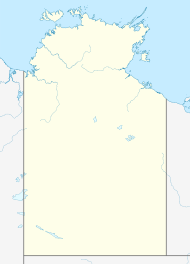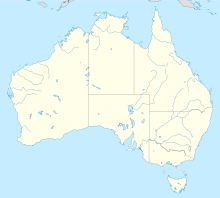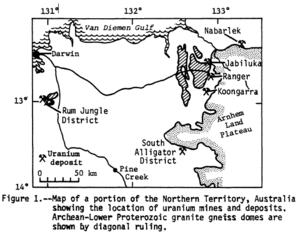Rum Jungle, Northern Territory facts for kids
Quick facts for kids Rum JungleNorthern Territory |
|
|---|---|
| Population | 84 (2016 census) |
| Postcode(s) | 0845 |
| LGA(s) | Coomalie Shire |
| Territory electorate(s) | Daly |
| Federal Division(s) | Lingiari |
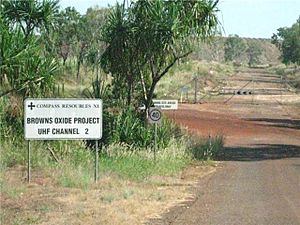
Browns Oxide Project entry gate
|
|
| Location | |
|---|---|
| Location | Batchelor |
| Territory | Northern Territory |
| Country | Australia |
| Coordinates | 12°59′S 131°01′E / 12.983°S 131.017°E |
| Production | |
| Products | Uranium |
| History | |
| Opened | 1950 |
| Closed | 1971 |
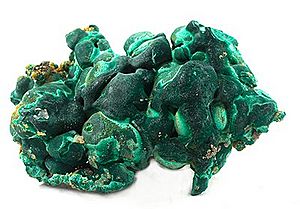
Rum Jungle is a small area in Australia's Northern Territory. It is also known by its traditional name, Unrungkoolpum. This place is about 105 kilometres south of Darwin. It sits near the East Branch of the Finniss River. Rum Jungle is also very close to Litchfield National Park. It is just 10 kilometres west of Batchelor.
The traditional owners of this land are the Kungarakan and Warai peoples. Their rights to this land were officially recognised in May 1981.
The name "Rum Jungle" comes from an event in March 1873. Some workers were moving supplies between Southport and Pine Creek. They opened a barrel of rum and shared it with local miners. The next morning, one worker and some gold had disappeared. People searched for months until the worker and the gold were found. The name "Rum Jungle" was first used in November 1873.
A well-known early resident was Nellie Flynn. She arrived in 1909 with her family. Nellie lived in the area until the 1970s.
Rum Jungle is most famous for its uranium deposit. This valuable mineral was found in 1949 and later mined.
Contents
Exploring Rum Jungle's Past
The first European to visit the Rum Jungle area was George Goyder in 1869. On his trip, he saw a green rock that looked like copper. This rock was later identified as torbernite. At first, not many people paid attention to this discovery.
Later, in the 1870s, many Europeans and Chinese people came to the area. They were looking for gold. They also mined small amounts of copper and other minerals.
These new arrivals brought different illnesses to the local Aboriginal people. Diseases like smallpox and tuberculosis affected them. The arrival of new people also changed the Aboriginal way of life.
Mining for Minerals
Uranium Mining History
In April 1948, the Australian Government offered a reward of £25,000. This was for anyone who found uranium ore in Australia. The reward was offered because uranium was needed more after World War II. The United States and Britain thought Australia might have a good supply.
In 1949, a man named John Michael "Jack" White found torbernite. He found it in old copper mining shafts nearby. Jack White was a buffalo hunter and prospector. He recognised the uranium from a colour pamphlet. He took his samples to Darwin in August 1949. Later, he received the full reward. News of his discovery spread across Australia.
Work on the mine began during the war. In 1952, the Australian Government helped build a mine and a processing plant. This plant would turn uranium ore into a concentrated form. This was part of a deal with the UK-US Combined Development Agency. The deal lasted from 1953 to 1962.
The mine officially opened on 17 September 1954. The Australian Prime Minister, Robert Menzies, attended the event. He spoke about uranium's importance for Australia's defence. He also hoped it would be used for good things. Days before the opening, four mine workers died in a truck accident.
The Australian Government was in charge of the mine. A company called Territory Enterprises Pty Limited managed it. This company was part of the Rio Tinto Group. The nearby town of Batchelor grew a lot. Most of the mine workers lived there.
By 1959, most of the easily reachable uranium ore was gone. Mining continued on a small scale until 1963. The processing plant kept working until April 1971. It processed uranium ore from Rum Jungle and other places. In total, 863,000 tonnes of uranium ore were processed. Some was sold, and some was stored.
Environmental Cleanup Efforts
The Rum Jungle mine closed in April 1971. The site, covering about 200 hectares, was left as it was. The government agency in charge decided not to clean it up. The mining company also said they were not responsible. This caused the mine to become one of Australia's most polluted places.
Acid and metals flowed into the East Branch of the Finniss River. This happened because of the minerals in the ground and the heavy rainfall. These conditions caused harmful chemicals to be released.
A first attempt to clean up Rum Jungle happened in 1977. This led to a bigger cleanup plan. In 1983, a program costing A$16.2 million began. Its goal was to remove heavy metals and make the waste less harmful. Justice Russell Fox, who looked into the environmental issues, said:
[Rum Jungle] represents to many people, not least of all the Aboriginal people, an awful example of what should not be allowed to happen.
After mining, the area had high levels of radiation. This included gamma radiation and radioactive dust. These levels were so high that more cleanup was needed in 1990. An extra $1.8 million was spent to improve waste areas.
Uranium mining creates a lot of radioactive waste called tailings. The main radioactive part is uranium-238. This type of uranium is not very radioactive. It has a very long half-life of 4.47 billion years. A longer half-life means it decays slower and is less radioactive.
In 2003, a survey found that the covers on the waste piles had failed. They were supposed to last 100 years but failed in less than 20. The local and federal governments are still discussing who should pay for more cleanup. Contamination of underground water is also still a problem.
Rum Jungle Lake for Fun
One big challenge in cleaning up the Rum Jungle Creek South mine was that it became a lake. This is now known as Rum Jungle Lake. It is special because it is one of the few lakes in the Darwin area without crocodiles. After the mine closed, it became very popular for swimming, canoeing, and scuba diving.
In November 2010, swimming was stopped because of low radiation levels. After more tests, it was found to be safe. The lake reopened in October 2012. As of June 2024, the Coomalie Community Government Council is planning more cleanup work for the lake.
Browns Oxide Project
In 2001, a company called Compass Resources proposed a large mining project. It was called the Browns Polymetallic Project. This project aimed to mine lead, cobalt, copper, nickel, and silver. It was planned to last for at least 15 years. Compass also thought this project might help clean up the old uranium mining area.
Compass stopped work on this big project in 2002. Metal prices were low, and their financial partner left.
In 2005, Compass suggested a smaller project. This one focused on mining cobalt, nickel, and copper. Because it was smaller, Compass could manage it alone.
The Northern Territory Government looked at this new project. The Minister for Natural Resources, Environment and Heritage said it "can be managed without unacceptable environmental impacts."
The Minister for Mines and Energy announced this approval in May 2006. This project was expected to start production in early 2007. The approval needed a final check by the Commonwealth Government.
The Browns Oxide Project is near the old Rum Jungle mine. But it mines copper, cobalt, and nickel, not uranium. However, Compass has a lease for the old Rum Jungle site. They are interested in mining uranium there in the future. Any plan to mine uranium would need a completely new application and environmental review.
Understanding the Rocks and Land
The main uranium areas at Rum Jungle are found near a large crack in the earth called the Giant's Reef Fault. These valuable minerals are found in ancient rocks. These rocks include carbonaceous slate and graphitic schist. They are part of the Lower Proterozoic Brooks Creek Group.
The minerals are located in a folded rock structure called an anticline. This anticline is on the side of a large rock dome made of granite. The main minerals found here include chalcopyrite, bornite, bournonite, pyrite, and uraninite. When these minerals react with air and water, they form other colourful minerals. These include azurite, malachite, pseudomalachite, and various uranium minerals like torbernite.


